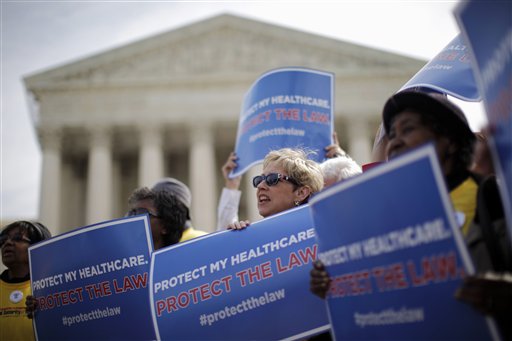(AP) Justices meet Friday to vote on health care case
By MARK SHERMAN
Associated Press
WASHINGTON
While the rest of us have to wait until June, the justices of the Supreme Court will know the likely outcome of the historic health care case by the time they go home this weekend.
After months of anticipation, thousands of pages of briefs and more than six hours of arguments, the justices will vote on the fate of President Barack Obama’s health care overhaul in under an hour Friday morning. They will meet in a wood-paneled conference room on the court’s main floor. No one else will be present.
In the weeks after this meeting, individual votes can change. Even who wins can change, as the justices read each other’s draft opinions and dissents.
But Friday’s vote, which each justice probably will record and many will keep for posterity, will be followed soon after by the assignment of a single justice to write a majority opinion, or in a case this complex, perhaps two or more justices to tackle different issues. That’s where the hard work begins, with the clock ticking toward the end of the court’s work in early summer.
The late William Rehnquist, who was chief justice for nearly 19 years, has written that the court’s conference “is not a bull session in which off-the-cuff reactions are traded.” Instead, he said, votes are cast, one by one in order of seniority.
The Friday conference also is not a debate, says Brian Fitzpatrick, a Vanderbilt University law professor who worked for Justice Antonin Scalia 10 years ago. There will be plenty of time for the back-and-forth in dueling opinions that could follow.
“There’s not a whole lot of give and take at the conference. They say, `This is how I’m going to vote’ and give a few sentences,” Fitzpatrick said.
It will be the first time the justices gather as a group to discuss the case. Even they do not always know what the others are thinking when they enter the conference room adjacent to Chief Justice John Roberts’ office.
By custom, they shake hands. Then Roberts will take his seat at the head of a rectangular table. Scalia, the longest serving among them, will be at the other end. The other seven justices also sit according to seniority, the four most junior on one side across from the other three.
“They generally find out how the votes line up at the conference,” said Orin Kerr, a George Washington University law professor who worked for Justice Anthony Kennedy nine years ago.
The uncertainty may be especially pronounced in this case, where the views of Roberts and Kennedy are likely to decide the outcome, Kerr said in an interview Thursday. “I don’t think anyone knows. I’m not sure Justice Kennedy knows.”
No one’s vote counts more than the others’, but because they speak in order of seniority, it will become clear fairly quickly what will become of the health care overhaul.
That’s because Roberts speaks first, followed by Scalia, then Kennedy. If the three men hold a common view, the Obama health care overhaul probably is history. If they don’t, it probably survives.
If Roberts is in the majority, he will assign the main opinion, and in a case of this importance, he may well write it himself, several former law clerks said. If Roberts is a dissenter, the senior justice in the majority assigns the opinion.
The court won’t issue its ruling in a case until drafts of majority opinions and any dissents have circulated among the justices, changes have been suggested and either accepted or rejected.
“These justices aren’t locked in. Minds have changed during the drafting process and minds have changed after opinions have been circulated,” said Rick Garnett, associate dean and professor of law at Notre Dame Law School who worked for Rehnquist 15 years ago.
In one celebrated case decided in 1992, Rehnquist initially assigned Kennedy to write a majority opinion for five justices allowing prayers at public school graduations. In the end, Kennedy ended up writing the opinion for a different five-justice majority striking down the graduation prayers. According to several accounts, Kennedy simply changed his mind during the writing process.
No one will know precisely when decisions on particular cases will be coming, until perhaps Roberts ends a court session in late June by announcing the next meeting will be the last until October. Then it’s a safe bet that whatever hasn’t been decided will be on the last day. And decisions in the biggest cases very often aren’t announced until that last day of the term.
Supreme Court opinions rarely find their way to the public before they are read in the marble courtroom, although the court inadvertently posted opinions and orders on its website about a half hour too soon in December.
The last apparent security breach occurred more than 30 years ago when Tim O’Brien, then a reporter for ABC News, informed viewers that the court planned to issue a particular opinion the following day. Chief Justice Warren Burger accused an employee in the printing shop of tipping O’Brien and had the employee transferred to a different job.
Sometimes, though, the justices themselves manage to let people know something big is coming.
On May 17, 1954, the attorney general, secretary of state and Nina Warren, wife of the chief justice, were in the courtroom when Earl Warren read the historic, unanimous opinion in Brown v. Board of Education outlawing school segregation.

COMMENTS
Please let us know if you're having issues with commenting.